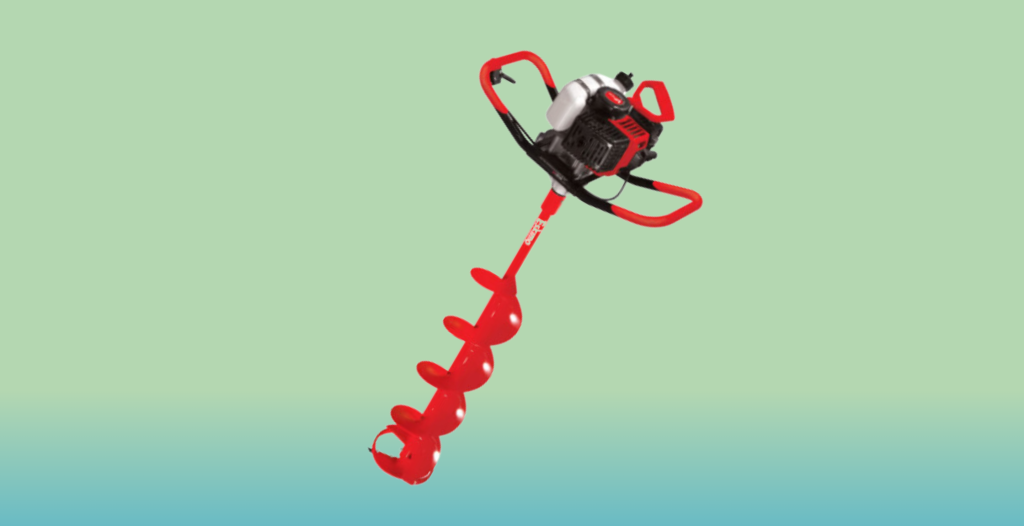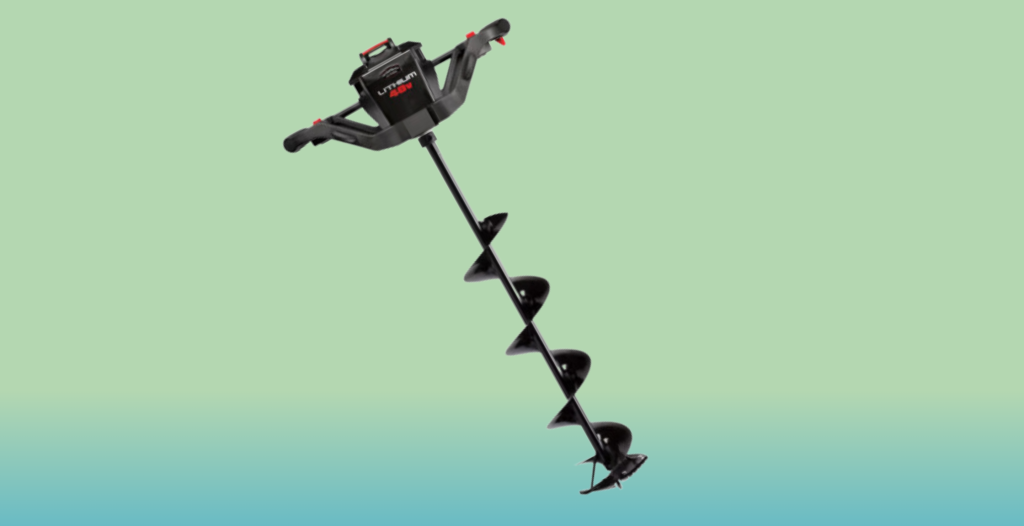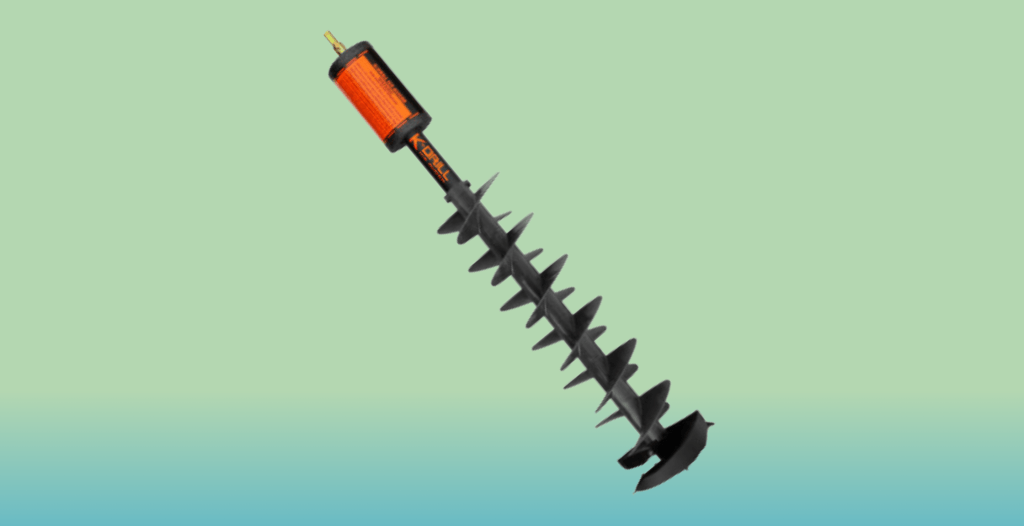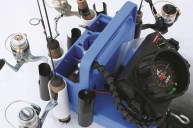If you watched The Office, you might recall the episode where Dwight Schute tries to buy an auger. I didn't even know what an auger was the first time I watched that episode in 2015. When I started ice fishing in 2019, I was surprised to learn that augers are an important piece of ice fishing gear, and I desperately wanted my own.
Augers, along with tip-ups, are an essential ice fishing tool. In many cases, it is literally impossible to go ice fishing without one. Augers are what drill into the surface of frozen bodies of water, allowing ice anglers to drop a line and access fish swimming underneath their fishing hole.
I started ice fishing with a hand auger. I quickly realized I was too short and weak to use one effectively. Where I ice fish, slicing through two feet of ice to access the water is standard, and I like to drill over 20 holes in one outing. Back then, I needed to fish with a buddy so we could drill holes together. When I started solo fishing and guiding ice fishing trips, I upgraded to an electric auger, allowing me to easily drill many holes like a pro.
Depending on where you live, you may prefer one type of auger over another. Here's a breakdown of why you want an auger, how to use it, and our favorite ice-fishing auger picks.
Why You Want an Ice Fishing Auger
Unless you live in a state where it's legal to use a chainsaw or ice saw to cut rectangles out of the ice for spearfishing, you're stuck buying an auger. You might not want to take a big hit to the bank account but trust me, if you're going to ice fish, you need an auger.
Thankfully, augers are available at many price points. They're also intuitive to use and only require a little muscle. Some augers are lighter than others, but you'll need to maintain a firm grip on any auger while drilling to stay safe on the ice. Additionally, I find it's easier to drill holes with heavy augers since the weight pulls the drill bit down, saving you from pushing it down.
Augers come in a variety of power types, sizes, and weights. Deciding what type of auger you need before shopping for one is important. If the ice doesn't get much thicker than 10 inches where you live and you plan to chase panfish, a 6-inch hand auger may be the way to go. If you're outfitted with a snowmobile and an ice fishing sled, a 10-inch gas auger might be a better option.
How to Use Ice Fishing Augers
Using ice augers isn't too tricky. The hardest part is drilling a straight hole. Be careful not to drill your hole at an angle. Otherwise, you'll have difficulty jigging, using your electronics, and bringing fish up through the hole.
Regardless of what auger you use, lift it up and down while drilling to help clear icy slush from your hole. The corkscrew-like flighting carries the ice shavings up and out of the hole, reducing the time you'll need to scoop it out by hand. If your auger is too short to drill through your local ice, many companies make auger extensions. Additionally, if your auger blades get dull, you can order replacement blades, get them sharpened by a professional, or use a sharpener to bring them back to life. Hand-powered augers are the easiest auger to use, in some ways; they also require the most muscle. Be careful not to drop your hand auger down your ice fishing hole. They fit in the hole you just made—and if you let go, they will drop through to the bottom of the lake. Don't ask me how I know this. Gas augers are intimidating but also the most effective auger. They're heavy, messy, and high-powered. They're also the most common type of powered auger, and honestly, they make my battery-powered auger look cute. When drilling with a gas auger, let the weight of the auger do the work. They're top-heavy, so when you go to drill, the weight of the 4-stroke motor puts pressure on the blades, helping them bite into the ice. Electric ice augers, or battery-powered augers, are arguably the easiest type of power auger to use. Just remember to charge up the battery before heading out on the ice. Electric ice augers have both forward and reverse rotation modes. If your auger gets stuck in the ice, hitting the reverse button and carefully backing it out can be handy. Drill bit augers are similar to battery-powered augers because you use a cordless drill battery to activate the auger blades. Don't forget to charge up your drill's batteries the night before you go fishing. When you're ready to drill ice holes, insert your auger drill bit into your drill's chuck. Ensure it's secure, and then operate your drill normally.
What To Look For When Shopping For Ice Augers
When shopping for ice augers, four things to keep in mind are the auger's power type, weight, diameter, the depth of the ice you plan to drill into, and how frequently you plan to drill holes. Let's dive into these components a bit more. As previously mentioned, there are four main types of ice augers: hand, gas, battery, and drill. Hand augers are the only types that are not powered. As a result, they can be tiring to use for a weekend of ice fishing. However, they're also the lightest and most affordable type of auger. Gas augers are a high-powered piece of equipment that rapidly drill holes day in and day out. They're also the heaviest type of auger, a pro and a con. They can be difficult for smaller-framed people to handle, but their excess weight punches through ice like a knife. Gas augers can also be messy if oil leaks or you need to refuel. Consider packing extra gas out on the ice depending on how much you plan on using your gas auger. Lithium battery-powered augers fall between hand augers and gas augers. They're lighter, quieter, and cleaner than gas augers, but heavier than hand augers. However, they're also the priciest type of auger. The batteries last for one or two outings; they'll need recharging after a full day outdoors. Additionally, the batteries are susceptible to cold, so remove them from the auger and stash them somewhere warm when not in use. Drill bit augers are quite comparable to battery-operated power augers. They're lighter than electric augers, but the loudness, cleanliness, and price tag are similar. The batteries are also susceptible to the cold but generally last longer than lithium auger batteries. Will you pull your ice fishing sled, or are you hooking it up to a snowmobile? Depending on whether you pull your gear or not, the weight of your auger comes into play. You might not want a 30-pound gas auger, your shelter, and fishing tackle in your sled if you're pulling it yourself. Conversely, you might want to splurge on a 25-pound battery-powered auger if your snow machine is going to pull it, not you. Purchase an auger whose diameter matches the types of fish you plan on catching. If perch, bluegill, and sunfish are your jam, get a 6-inch auger. If you plan on fishing for sunfish and larger fish like largemouth bass, 8-inch augers are perfect. If you only plan on ice fishing for northern pike and other monsters, get a 10-inch diameter blade. Remember that larger diameters require more energy from your auger to drill and pose a bigger tripping hazard than smaller holes. If the ice tends to be only 6-8 inches on your local waters, a hand auger is the way to go. It'll save you money and get a little workout in. If you live in an arctic tundra and the ice can be two feet or thicker, get a power auger. You will tire out quickly if you drill into thick ice with a hand auger. Like ice depth, ice anglers who don't plan on drilling many holes, especially in ice that isn't thick, might want to get a hand auger. Alternatively, if you love to punch 25 holes every time you ice fish, especially in thick ice, splurge on a power auger. You'll exhaust yourself if you try to drill that many holes through thick ice. Additionally, if you love to drill, consider how long a battery or tank of gas will last you. Most auger brands tout that their products can drill 100+ holes in one go. Depending on the fishing conditions, that may or may not be true. You can get about 125 holes if drilling less frequently through thinner ice and 75 if drilling many holes in thick ice.
Our Top Picks
Eskimo 8" Hand Ice Auger

Wide Open Spaces
Power Type: Manual | Weight: 7.5 lbs | Hole Size: 8 inches
Eskimo's sturdy hand auger is a great option for folks leaning toward an unpowered auger. The 8-inch diameter is versatile and useful for almost every fish species. It's steel, so you can leverage your weight while drilling and the handle won't bend or break. The stainless steel blades will hold their edge all season long and can be resharpened when the time comes.
This auger weighs a mere 7.5 pounds. Whether you pull it yourself or drag it behind a snowmobile, it won't weigh down your sled. If you're looking for the perfect hand auger, you can stop searching here.
Eskimo Sting Ray 8'' Power Ice Auger

Wide Open Spaces
Power Type: Gas | Weight: 28 lbs | Hole Size: 8 inches
Pick up Eskimo's Sting Ray gas-powered auger if you're not looking to mess around. This thing shreds through ice like a boss. It has stainless steel blades that drill 8-inch diameter holes, a blade protector, and a centering ring. It features a primer button that ensures quick, smooth start-ups. Plus, the see-through gas tank takes out any guesswork regarding how much fuel you have left.
Although this 28-pound auger is pretty heavy, that added weight will help it pierce through ice. However, it's a lot to drag behind you if you don't have a snowmobile.
Rapala StrikeMaster Lithium 40V Ice Auger

Wide Open Spaces
Power Type: Battery | Weight: 24 lbs | Hole Size: 8 or 10 inches
I use this auger to fish recreationally and guide my ice-fishing clients. The battery charges up quickly and is easy to insert into the auger. It's lighter than a gas auger, so it's easy for me to carry it onto the ice and pick it up to drill holes with. It's also far quieter than a gas auger, allowing me to talk and drill simultaneously.
On extra-cold days, I must remove the battery from the auger and put it in my jacket or inside my ice shelter to protect its charge. However, on clear, warm days, I angle the battery towards the sun, keeping it warm. Overall, this is my favorite auger I've ever used, and its pros significantly outweigh the few cons of using a lithium battery auger.
K-Drill Ice Auger

Wide Open Spaces
Power Type: Drill Battery | Weight: 5 lbs (not including drill) | Hole Size: 7.5 or 8.5 inches
If you own a half-inch chuck cordless power drill, getting an ice auger drill bit is undoubtedly the way to go. Additionally, if you already know how to operate your drill, you already know how to use this auger. The K-Drill Ice Auger weighs only 5 pounds, and even with a 3-pound drill attached to it, it is over 10 pounds lighter than an electric auger. Charge up your drill's battery the night before, and you're ready to hit the ice. Consider picking up an extra battery for your drill if you don't have one already to extend this auger's battery life in the cold further.
Editor's Note: Our editors independently select products featured on Wide Open Spaces. However, we may earn a commission when you buy something through our links.




